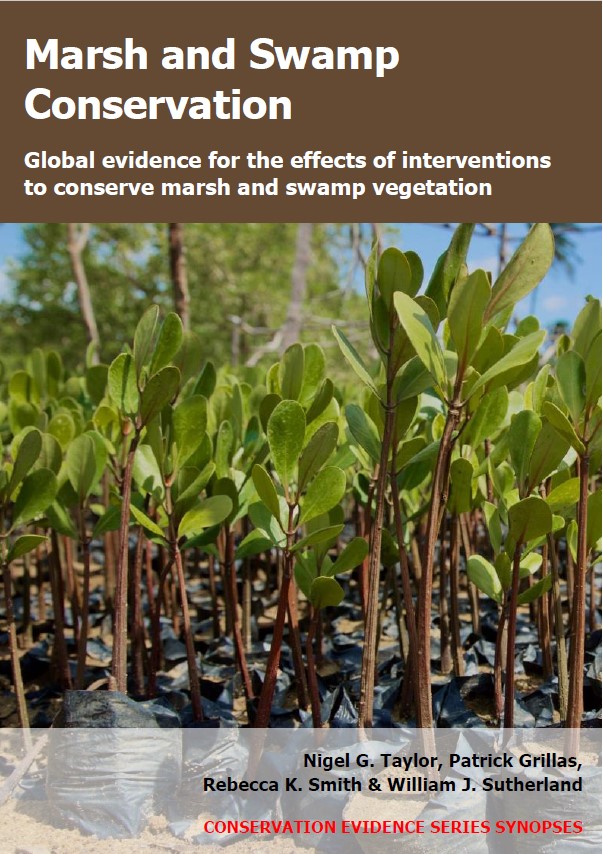Actions to conserve biodiversity
We have summarised evidence from the scientific literature about the effects of actions to conserve wildlife and ecosystems.
Review the evidence from the studies
Not sure what Actions are? Read a brief description.
Search for evidence
e.g. "frogs chytrid"
441 Actions found
Refine
Hide
441 Actions found
Download Actions
| 0 selected |
|
Order results by:
| Action | Effectiveness | Studies | Category | |
|---|---|---|---|---|
|
Introduce tree/shrub seeds or propagules: freshwater wetlands Action Link |
Unknown effectiveness (limited evidence) | 2 |
|
|
|
Facilitate tidal exchange before/after planting non-woody plants: brackish/saline wetlands Action Link |
Unknown effectiveness (limited evidence) | 2 |
|
|
|
Create mounds or hollows before planting non-woody plants: freshwater wetlands Action Link |
Unknown effectiveness (limited evidence) | 2 |
|
|
|
Disturb soil/sediment surface before planting non-woody plants: brackish/saline wetlands Action Link |
Unknown effectiveness (limited evidence) | 2 |
|
|
|
Add inorganic fertilizer before/after planting trees/shrubs: freshwater wetlands Action Link |
Unknown effectiveness (limited evidence) | 2 |
|
|
|
Transplant wetland soil before/after planting non-woody plants: freshwater wetlands Action Link |
Unknown effectiveness (limited evidence) | 2 |
|
|
|
Introduce nurse plants to aid focal non-woody plants: freshwater wetlands Action Link |
Unknown effectiveness (limited evidence) | 2 |
|
|
|
Prune roots of trees/shrubs before planting: freshwater wetlands Action Link |
Unknown effectiveness (limited evidence) | 2 |
|
|
|
Treat tree/shrub seeds with chemicals before sowing: freshwater wetlands Action Link |
Unknown effectiveness (limited evidence) | 2 |
|
|
|
Pay stakeholders to protect marshes or swamps Action Link |
Unknown effectiveness (limited evidence) | 2 |
|
|
|
Engage local people in management/monitoring of marshes or swamps Action Link |
Likely to be beneficial | 2 |
|
|
|
Provide education/training programmes about marshes or swamps Action Link |
Unknown effectiveness (limited evidence) | 2 |
|
|
|
Flood cropland when fallow to conserve freshwater marshes Action Link |
Unknown effectiveness (limited evidence) | 1 |
|
|
|
Cut/remove/thin forest plantations: freshwater marshes Action Link |
Unknown effectiveness (limited evidence) | 1 |
|
|
|
Use barriers to keep livestock off ungrazed brackish/salt marshes Action Link |
Unknown effectiveness (limited evidence) | 1 |
|
|
|
Exclude or remove livestock from historically grazed brackish/saline swamps Action Link |
Unknown effectiveness (limited evidence) | 1 |
|
|
|
Abandon aquaculture facilities: allow brackish/saline marshes or swamps to recover without active intervention Action Link |
Unknown effectiveness (limited evidence) | 1 |
|
|
|
Abandon mined land: allow brackish/saline marshes or swamps to recover without active intervention Action Link |
Unknown effectiveness (limited evidence) | 1 |
|
|
|
Plug/dam canals or trenches: freshwater marshes Action Link |
Unknown effectiveness (limited evidence) | 1 |
|
|
|
Reduce intensity of vegetation harvest: freshwater swamps Action Link |
Unknown effectiveness (limited evidence) | 1 |
|
|
|
Use low-impact methods to harvest vegetation: freshwater swamps Action Link |
Unknown effectiveness (limited evidence) | 1 |
|
|
|
Cut large trees/shrubs to maintain or restore disturbance: freshwater swamps Action Link |
Unknown effectiveness (limited evidence) | 1 |
|
|
|
Use herbicide to maintain or restore disturbance: freshwater marshes Action Link |
Unknown effectiveness (limited evidence) | 1 |
|
|
|
Use herbicide to maintain or restore disturbance: freshwater swamps Action Link |
Unknown effectiveness (limited evidence) | 1 |
|
|
|
Remove plant litter: freshwater marshes Action Link |
Unknown effectiveness (limited evidence) | 1 |
|
Download Actions
| 0 selected |
|

Marsh and Swamp Conservation - Published 2021
Marsh and Swamp Synopsis
Watch this search
If you are familiar with RSS feeds, please click the button below to retrieve the feed URL:
RSS feed for this searchIf you are unfamiliar with RSS feeds, we would suggest reading this BBC article.
Unfortunately, due to the number of feeds we have available, we cannot provide e-mail updates. However, you could use tools such as Feed My Inbox to do this for you.
What are 'Individual studies' and 'Actions'?
Individual studies
An individual study is a summary of a specific scientific study, usually taken from a scientific journal, but also from other resources such as reports. It tells you the background context, the action(s) taken and their consequences.
If you want more detail please look at the original reference.
Actions
Each action page focuses on a particular action you could take to benefit wildlife or ecosystems.
It contains brief (150-200 word) descriptions of relevant studies (context, action(s) taken and their consequences) and one or more key messages.
Key messages show the extent and main conclusions of the available evidence. Using links within key messages, you can look at the paragraphs describing each study to get more detail. Each paragraph allows you to assess the quality of the evidence and how relevant it is to your situation.
Where we found no evidence, we have been unable to assess whether or not an intervention is effective or has any harmful impacts.





)_2023.JPG)














